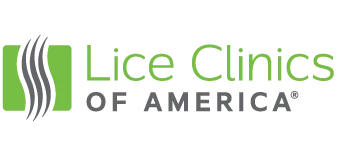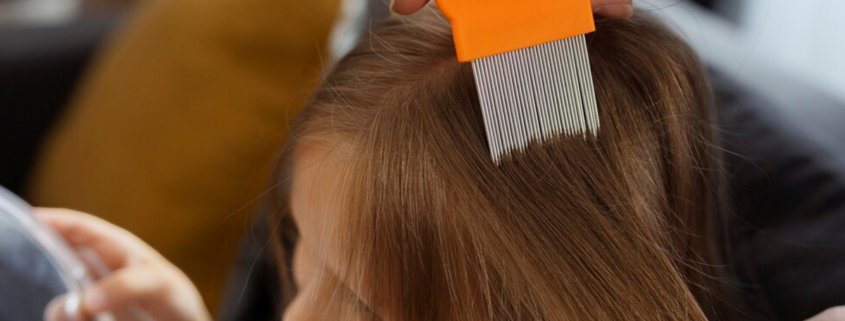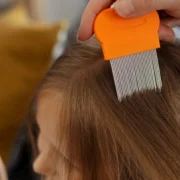What Are Nits?
Head lice are tiny bugs that cause itching and irritation on the scalp. Children make up the majority of patients seen at lice clinics across the country, as the levels of transmission are significantly higher in their age group. At Lice Clinics of America located in Anderson, Spartanburg, and Greenville South Carolina, we are the leaders in treating head lice infestations. Our FDA-Approved technology has revolutionized the world of treating head lice, with a 99% effective rate and guaranteed one treatment appointment.
While treating head lice is important, understanding what they are and how they spread, as well as noting the common misconceptions surrounding treatment and transmission, are equally as important. At Lice Clinics of America in Anderson we believe that treatment isn’t just physical but also mental because having the correct information about head lice can prevent future infestations from occurring.
What Are Nits In The Hair?
Nits are another word for lice eggs. They are laid by the adult female head louse, often at the base of the hair shaft closest to the scalp, about 1/4 inch above it. What makes them difficult to remove using a traditional comb is due to their small size but also how they are attached to the hair shaft. They are about the size of a knot in a piece of thread and are therefore incredibly difficult to see as well.
Nits have a yellow or white appearance, although in some cases they can be the same color as the hair of the infected individual. Another factor that makes nits challenging to treat is because they are often confused with dandruff, hair spray droplets, or scabs from open wounds on the scalp. The average amount of time it takes for lice to hatch from its nit is around 8-9 days.
Nymph and Adult: The Next Life Cycle Stages of a Louse
After a nit catches, it turns into a nymph. It looks like an adult head louse but is smaller in size. In order for it to live, it must feed on blood. After about 9-12 days Nymphs fully mature into adults.
A sesame seed. That’s the average size of a fully-grown head louse. It’s tan/grey in color, although just like nits they can be darker in persons with darker hair. On a different note, adult head lice share similar characteristics to Nymphs in that they must feed on blood constantly in order to survive. They can live for about 30 days on the head and female head lice lay on average about six eggs a day. If head lice fall off the scalp they die shortly after, about one or two days and female head lice are typically larger than males.
Where Are Lice and Nits In The Hair Found?
Head lice are almost exclusively located on the scalp in what is commonly known as hot spots: behind the ears, at the base of the neck, around the hairline, and on the crown of the head. Lice removal requires a specific and unique treatment technique because of the physical traits of the lice. They have little claws on the end of each of their six legs shaped like hooks, attaching themselves tightly to the hair strands. Because of this, it makes them incredibly challenging to treat and remove without the proper tools.
Symptoms and Common Causes of Transmission
Some common symptoms of a head lice infestation are a tickling feeling of something moving in the hair, intense itching, irritability sleeping, and sores on the head caused by scratching.
The easiest way for head lice to spread is through direct contact with a positive case through sharing hair tools or headwear. Even sharing pillows or lying in the bed of an infested individual.
Common Myths Debunked
Mayonnaise does not “suffocate” head lice or nits. The best way to treat an infestation is to seek professional help from a licensed clinician at either our Greenville, Anderson, or Spartanburg locations.
Swimming cannot spread lice. Despite head lice proving to survive underwater for several hours, their hook-like claws allow them to hold firm to the hair shaft. Meaning they are unlikely to leave the head of an affected individual. Chlorine levels found in pool water do not kill head lice.
Lice cannot be spread through hats, hair pieces, hair brushes, or anything other than direct head-to-head contact. Have your child take warning when sharing hugs, taking pictures, playing, and sleepovers.
Head lice do not spread diseases. However, constant head scratching can lead to scalp irritation, which might then lead to a secondary bacterial infection. But an individual will not get sick from head lice directly.
One Time, One Treatment: The AirAllé
At each of our head lice clinics in Spartanburg, Anderson, or Greenville, we use a special device called the AirAllé. It is the only FDA-cleared medical device in South Carolina that uses heated air for the treatment of head lice. This treatment is completely pesticide free and even kills super lice.
The AirAllé is a $199 3-step process that begins with a 30-minute treatment from the device that uses heat to dehydrate the lice and their eggs. Next, there’s a 30-minute comb-out to remove the dead lice and eggs from the hair, and finally an oil application. We are so confident in this treatment that we guarantee 99% effectiveness without a follow-up service. We offer a 30-day service re-treatment policy for those very few cases in which the treatment was not 100% effective. This re-treatment service is free of charge and will be provided to all family members that were checked and treated in our clinic.
Other Lice Removal Treatments
The Express AirAllé treatment is $175 and consists of a 30-minute AirAllé treatment and a 10-minute comb-out to remove some of the dead lice and dehydrated eggs. This option is best for those who have short hair. This treatment also includes a 30-day service re-treatment policy.
A comb-out is for those patients who are under the age of four or whom the AirAllé poses a risk to them or their health. Meaning that the AirAllé cannot be used on individuals who cannot sense pain or temperature, who have open wounds on their scalp, who cannot communicate discomfort, who have received radiation treatment of the head within the last six months, who have cranial or facial implants, or who have hair that cannot be combed through with a standard comb.
Instead, we offer a comb-out service which is a traditional strand-by-strand treatment where we use a specialized comb to remove the lice and their eggs by hand. We will use only non-toxic products. This specific treatment option requires the purchase of an at-home comb-out kit, 30 minutes of combing every day for 10 days, an oil application on days 5 and 10, and lastly a clinic recheck on day 11. A re-treatment policy is not offered for this service.
Lastly, we offer a do-it-yourself lice removal kit. We will provide all the topical treatment products needed, a professional lice comb, and detailed instructions on how to properly perform the comb-out procedure. The individual performing this treatment will need to conduct several follow-up sessions during the next 10 days.
The Lice Clinics of America Difference
Our company is the largest professional lice treatment network with more than 950,000 successful treatments. Our head lice clinics in Spartanburg, Greenville, or Anderson have the best-licensed professionals in South Carolina. We offer screenings and multiple treatment options with affordability in mind to ensure the best course of action for each of our patients. For more information on our services, visit our website!












Leave a Reply
Want to join the discussion?Feel free to contribute!